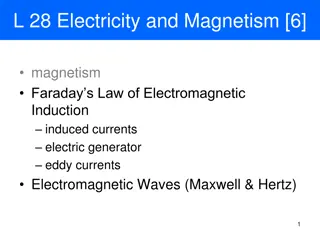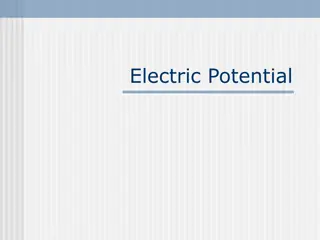Understanding Electric Currents and Resistance II in Physics
Capacitors, resistance, energy usage, and the microscopic picture of conductivity are explored in this lecture on electric currents and resistance II in Physics 2415. Discover the relationship between voltage, charge, current, and resistance, along with insights into power usage, resistivity, and the behavior of electrons in conductors. Gain a comprehensive understanding of how electricity flows and is utilized in various materials and devices.
Download Presentation

Please find below an Image/Link to download the presentation.
The content on the website is provided AS IS for your information and personal use only. It may not be sold, licensed, or shared on other websites without obtaining consent from the author. Download presentation by click this link. If you encounter any issues during the download, it is possible that the publisher has removed the file from their server.
E N D
Presentation Transcript
Electric Currents and Resistance II Physics 2415 Lecture 11 Michael Fowler, UVa
Todays Topics First we ll mention capacitors Power usage: kWh, etc. The microscopic picture Temperature dependence of resistivity Drift speed and electron speed AC and DC Semiconductors and superconductors
Know This Capacitors in parallel (any number) are all at the same voltage V. Capacitors in series (any number) all carry the same charge Q. Putting these facts together with V = Q/C can solve a lot of problems! V V . -Q -Q Q Q C2 C1
Resistance and Resistivity To summarize: for a given material (say, copper) the resistance of a piece of uniform wire is proportional to its length and inversely proportional to its cross-sectional area A. = This is written: R A where is the resistivity. = 1.68 10 8 m. For copper,
Electric Power Remember voltage is a measure of potential energy of electric charge, and if one coulomb drops through a potential difference of one volt it loses one joule of potential energy. So a current of I amps flowing through a wire with V volts potential difference between the ends is losing IV joules per sec. This energy appears as heat in the wire: the electric field accelerates the electrons, which then bump into impurities and defects in the wire, and are slowed down to begin accelerating again, like a sloping pinball machine.
Power and Energy Usage Using Ohm s law, we can write the power use of a resistive heater (or equivalent device, such as a bulb) in different ways: 2 P IV I R V = = = 2/ R The unit is watts, meaning joules per second. Electric meters measure total energy usage: adding up how much power is drawn for how long, the standard unit is the kilowatt hour: 1 kWh = 1,000x3,600J = 3.6MJ
Microscopic Picture of Conductivity The total current down the wire is I; if we assume it s uniform over the cross section area A (which it is) there is a current density j = I/A. (units: amps/m2) A constant E field gives a steady current. This means the electrons are bouncing off things, like a sloping pinball machine, otherwise the current would keep accelerating.
What are the Electrons Bouncing off? Not the atoms! It s found experimentally that electrons pass dozens or often hundreds of atoms before being deflected. Furthermore, an extremely pure crystal of copper has a very low resistance if it s really cooled down .and the atoms are all still there.
What are the Electrons Bouncing off? Not the atoms! An extremely pure crystal of copper has a very low resistance if it s really cooled down . This is the clue: they are deflected by thermal vibrations of the lattice resistance increases with temperature. The electrons also bounce off impurities, but can pass through a pure cold lattice like light through glass electrons are really waves!
Temperature Dependence of Resistivity Resistivity of metals increases approximately linearly with temperature over a wide range. The formula is: = + ( ) 1 T T 0 0 T being the resistance at some fixed T0, and the temperature coefficient of resistivity. An old incandescent (not LED) bulb has a tungsten wire at about 3300K, and = 0.0045, from which . not far off proportional to temperature. 0 15 T 0
Clicker Question What is the resistance of a 12V, 36 Watt headlight bulb? A. 3 ohms B. 4 ohms C. 0.3 ohms
Clicker Answer What is the resistance of a 12V, 36 Watt headlight bulb? A. 3 ohms B. 4 ohms C. 0.3 ohms Power of 36W = IV, V = 12 so I = 3. Then I = V/R.
Clicker Question Assume the 12V, 36 Watt headlight bulb has a tungsten filament. What is its approximate power output in the first instant it is connected, cold, to the 12V battery? ( ). A. 36W B. 2.4W C. 540W 15 0 T
Clicker Answer Assume the 12V, 36 Watt headlight bulb has a tungsten filament. What is its approximate power output in the first instant it is connected, cold, to the 12V battery? ( ). A. 36W B. 2.4W C. 540W Power P = IV = V2/R: R when initially cold is 1/15 of R at operating temperature of 3300K. 15 0 T
Drift Speed Take a piece of copper wire, say 1mmx1mm cross section, 1m long carrying 5 amps. This is 1cc of Cu, about 10 gms, about 1023 conduction electrons (one per atom), about 15,000C of electron charge. Therefore, at 5 amps (C/sec) it takes 3000secs for an electron to drift 1m. Bottom line: the drift velocity is of order 10-4 m/sec. (it s linear in current, and depends on wire thickness for given current, obviously.)
Drift Speed and Electron Speed Take a piece of copper wire, say 1mmx1mm cross section, 1m long carrying 5 amps: this wire has resistance so from Ohm s law . This field will accelerate the electrons, ma = eE, approximate accn = 2x1010 m/s2. This reaches drift velocity in about 0.5x10-14 seconds, that must be time between collisions. Electron speed (from quantum mechanics) is about 2x106 m/s, so goes of order 10-8 m between collisions past dozens of atoms. = / 0.02 R A E 0.1 V/m
AC and DC Batteries provide direct current, DC: it always flows in the same direction. Almost all electric generators produce a voltage of sine wave form: sin2 V V ft = = sin V t 0 0 This drives an alternating current, AC, sin R V t = = sin 0 I I t 0 and power ( ) = = = = 2 2 0 2 2 2 sin / sin P VI I R I R t V R t 0
AC Average Power and rms Values ( ) = The AC power varies rapidly ( = 2 f, f = 60 Hz here), what is significant for most uses is the average power. The average value of sin2 t is . 2 2 0/ sin P V R t average value of sin2 t must equal average value of cos2 t. and remember sin2 t + cos2 t = 1 = = 2 Define Vrms by 0/ 2 V V V rms = 2 Then the average power rms/ V P R The standard 120V AC power is Vrms = 120V. So the maximum voltage V0 on a 120V line is 120x 2 = 170V!
Why Bother with AC? Because, as we ll discuss a little later, it s very easy to transform from high voltage to low voltage using transformers. This means very high voltages can be used for longer distance transmission, low voltages for local use.
Clicker Question The resistivity of aluminum is 58% higher than that of copper. A copper high voltage line has diameter 1 cm. If is replaced by an aluminum line of the same resistance, the aluminum line has diameter: A. 1.58cm B. 1.27cm C. 0.8 cm D. O.64 cm
Clicker Answer The resistivity of aluminum is 58% higher than that of copper. A copper high voltage line has diameter 1 cm. If is replaced by an aluminum line of the same resistance, the aluminum line has diameter: A. 1.58cm B. 1.27cm C. 0.8 cm D. O.64 cm area A, from which diameter up by factor 1.58. Remember R = L/A. The power lines have the same length, the aluminum therefore needs 58% more cross-section
High Voltage Power Lines Are made of aluminum you need 58% more than copper by volume, but less than half the weight, andit s about 65% cheaper per kg. No contest. Some steel may be added for strength.























